S-train (Copenhagen)
The Copenhagen S-train (Danish: S-tog) is the S-train of Copenhagen, Denmark. It is a hybrid urban-suburban rail serving the Copenhagen urban area, with the notable exception of Amager. The average distance between stations is 2.0 km, shorter in the city core and inner boroughs, longer at the end of lines that serve suburbs. Of the 86 stations, 32 are located within the central ticket fare zones, 1 and 2. The S-tog is analogous to S-Bahn systems in Germany, and is a separate system from the Copenhagen Metro, which operates in the city centre, Frederiksberg, and Amager.
 | |||
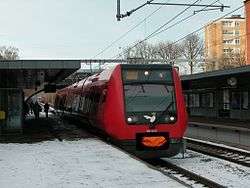 An S-train with coupler cover on the F line at Ålholm Station | |||
| Overview | |||
|---|---|---|---|
| Locale | Copenhagen urban area | ||
| Transit type | Commuter rail | ||
| Number of lines | 7 with 7 services | ||
| Number of stations | 85 | ||
| Annual ridership | 116 million (2016)[1] | ||
| Operation | |||
| Began operation | 1934 | ||
| Operator(s) | DSB S-tog | ||
| Technical | |||
| System length | 170 km[2] | ||
| Track gauge | 1,435 mm (4 ft 8 1⁄2 in) standard gauge | ||
| Electrification | 1,650 V DC Overhead lines | ||
| Top speed | 120 km/h (75 mph) | ||
| |||
On weekdays all stations are served at least every 10 minutes until the evening. There are six main lines and one peak hour support line. Since all lines, with exception of one, use the same path through the city core, train departures occur every second minute there, at the general limit of metro lines. On most suburban lines, trains depart every five minutes. On Sundays these time intervals are doubled.
The first line was opened in 1934, which was Klampenborg-Copenhagen H-Vanløse-Frederiksberg, with more lines soon after. Most were converted from steam operated railways to electric, metro-like operation and stations. Today the network forms the heart of public transport in the city, serving more than 357,000 passengers a day. (Together with the Metro they serve more than 500,000.) The S-train is owned and run by DSB S-tog A/S. Similar to the S-Bahn systems of Berlin, Vienna and Hamburg, the S-train network covers the entire greater urban area. The system is complemented by the Copenhagen Metro, regional trains, local diesel-powered trains within Metropolitan Copenhagen, an extensive bus network and two lines of shuttle boats called "harbour buses". The different networks use a common system for fare zones and tickets.
Copenhagen's two different city rail systems (separated from mainlines), the S-train and the Metro, serve more than half a million people a day, and the city's bus terminals are often adjacent to an S-train or Metro station. As of January 2009 there are 170 km of double track[2] and 84 S-train stations, of which eight are in neighbouring towns outside greater Copenhagen. At most of the termini other types of train are available for travel to the more remote towns in the metropolitan area (L-tog, diesel-powered local trains) or to the rest of Zealand and the other islands between the Great Belt and Øresund (regionaltog, regional trains). Trains across Øresund to Scania and its main city, Malmö, connect with the S-train network in the city centre.
In the city centre, the trains run underground in two tunnel sections, also served by regional trains. Elsewhere they are in the open, occasionally above or below street level. There is only one underground station, Nørreport, but many stations are elevated above street level (Fuglebakken, Jægersborg, Bernstorffsvej, Nordhavn, Sjælør, Sydhavn, Dyssegård, Jyllingevej, Vanløse and Vigerslev Allé). Flintholm, Ny Ellebjerg and Danshøj stations have tracks crossing each other at different levels with platforms on each level, while at Ryparken they are on the same level. The "ring line" or F line has an elevated section including Nørrebro Station, which offers a view of some of the most populous areas of the city, Nørrebro and Nordvest. Also, the junctions of the Farumbane with the other lines at Ryparken and Svanemøllen include a short elevated section and a short northbound tunnel, respectively. Within the city core (zones 1 & 2) the stations are either elevated or lower than the street level.
The S-train system has been entirely one-man operated since 1978.[3] Since 2009 free Wi-Fi Internet access has been available throughout the entire S-train system [4]
Network
The network consists of a central section that splits into three radial lines at each end, reaching the outer suburbs and neighbouring towns. The northern radials are:
- Farumbanen (formerly Hareskovbanen) (the Farum line) to Farum.
- Nordbanen (the north line) to Holte and Hillerød.
- Klampenborgbanen (the Klampenborg line) to Klampenborg.
The southern radials are:
- Køge Bugt-banen (the Køge Bay line) to Hundige, Solrød Strand and Køge.
- Vestbanen (the west line) to Høje Taastrup.
- Frederikssundbanen (the Frederikssund line) to Ballerup and Frederikssund.
The six radials are additionally connected by
- Ringbanen (the ring line) going between Hellerup in the north and Ny Ellebjerg in the south.
See articles about each of the seven components for station lists and service patterns.
Services
The December 2014 timetable has seven lines, each with a letter designation. Most run from about 0500 to about 0100 each day, with a train every 10 minutes in daylight hours and one every 20 minutes in the early morning and evening/night. The 10-minute interval begins later and ends earlier on weekends. Exceptions are service F, which runs once every 5 minutes (every 10 minutes on weekends); H, every 20 minutes in daytime to Østerport; and Bx, as an extra line on the Vestbanen and Hareskovbanen in the morning and afternoon(rush hours).
E, H and Bx skip certain stops to provide faster travel time, but no trains skip stops inside the ring line.
The network is slightly different on weekdays, weekends and nights.
As of January 2019, the line layout was changed on the northern branches as follows:
Weekday services
| Name | Southern end | Runs when | Northern end | ||
|---|---|---|---|---|---|
| All stops to Hundige, every second train continues to Solrød Strand | Køgebugtbanen | Daytime | Nordbanen | Limited stops to Hillerød | |
| All stops to Køge | Evening | ||||
| All stops to Høje Taastrup | Vestbanen | Daytime | Hareskovbanen | All stops to Farum | |
| Evening | All stops to Farum | ||||
| Limited stops to Høje Taastrup | Vestbanen | Morning/Afternoon | Hareskovbanen | All stops to Farum | |
| All stops to Ballerup, every second train continues to Frederikssund | Frederikssundbanen | Daytime | Klampenborgbanen | All stops to Klampenborg | |
| All stops to Frederikssund | Evening | ||||
| Limited stops to Hundige, then all stops to Køge | Køgebugtbanen | Daytime | Nordbanen | All stops to Holte | |
| All stops to Ny Ellebjerg | Ringbanen | All day | Ringbanen | All stops to Hellerup | |
| Limited stops to Frederikssund | Frederikssundbanen | Daytime | - | Terminates at Østerport | |
Before 2007, each line would run on a strict 20-minute schedule. In periods where more than three trains an hour were needed, the extra trains had separate service designations; for example service B+ ran on the same route as B, but only in the daytime and with its departure times offset 10 minutes from B.
Earlier timetables also had express services that skipped stops inside the ring line.
Weekend services
In the weekends, only lines A, B, C and F run, operating six times an hour between 1000 and 1800 and every 20 minutes outside this timespan. The weekend services are:
| Name | Southern end | Northern end | ||
|---|---|---|---|---|
| All stops to Køge | Køgebugtbanen | Nordbanen | All stops to Hillerød | |
| All stops to Høje Taastrup | Vestbanen | Hareskovbanen | All stops to Farum | |
| All stops to Frederikssund | Frederikssundbanen | Klampenborgbanen | All stops to Klampenborg | |
| All stops to Ny Ellebjerg | Ringbanen | Ringbanen | All stops to Hellerup | |
Night services
Starting November 2009, the network has had distinct night services that depart twice every hour on Friday and Saturday night. The night services are:
| Name | Southern end | Runs when | Northern end | ||
|---|---|---|---|---|---|
| All stops to Køge | Køgebugtbanen | Twice every hour | Nordbanen | All stops to Hillerød | |
| All stops to Høje Taastrup | Vestbanen | Twice every hour | Hareskovbanen | All stops to Farum | |
| All stops to Frederikssund | Frederikssundbanen | Twice every hour | - | Terminates at Copenhagen Central Station | |
| All stops to Ny Ellebjerg | Ringbanen | Twice every hour | Klampenborgbanen | All stops to Klampenborg | |
There is one service for each of the radials at night, stopping at every station.
Future
Two new stations are scheduled to be built: Favrholm (expected 2022, close to Hillerød) and Vinge (expected 2020),[5] close to Frederikssund.[6]
Since 30 trains per hour per direction now run between Dybbølsbro and Svanemøllen, building a new tunnel, running north–south in densely populated areas, has been discussed.[7]
The Vestbane line may easily be extended from Høje Taastrup to Roskilde, since tracks already exist. This has been discussed on several occasions, and is currently being investigated.[8] Extension from Klampenborg to Elsinore (converting the Kystbane railway to S-train standard) would prove more difficult, but the issue has been mentioned.[9] A problem is the lack of more capacity in the central tunnel.
Connecting Copenhagen Airport, Kastrup, to the network has been proposed, although it is already served by both regional trains and the Copenhagen Metro.
The Danish Transport Authority (Trafikstyrelsen) has suggested converting the F-line of the S-train network to metro standard as an M5 line, The only current interchange between the F line and the metro network are Flintholm Station and Nørrebro Station.
The F line is planned be driverless and 24/7 in 2024/2026.
The line Jægersborg–Hillerød has been upgraded from the proprietary HKT train control system to CBTC.[10]
Technical overview
S-trains run on standard-gauge tracks and are powered via overhead wires. The voltage is 1,500 or 1,650 volts DC (negative overhead wire), indicating that it varies considerably with the loading and distance from a feeder station. Power is drawn from the national grid through 38 feeder stations. They have to be relatively close to each other because the large currents in the overhead wires (caused by the relatively low voltage) would lead to unacceptably large transmission losses otherwise.
The primary signalling system is a fixed-block cab signalling system called HKT which transmits data to the trains through low-bandwidth audio frequency induction loops between the rails. Different frequency combinations encode different target speeds; when a train enters a block with a lower target speed than its current speed it will initiate service braking until the two match. This allows blocks to be much shorter than the full-speed braking distance, but as the braking profile is encoded in the transmitted target speed it only works where all trains have similar braking characteristics.
Lineside light signals are also provided in case of HKT failures or the occasional visit of a non-S-train, but the lineside blocks are longer so capacity in this mode is reduced. Precise train positions are visible on all lines in Byens puls (see links below).
Rolling stock
The S-train has seen four types of rolling stock. Currently, only fourth-generation trains operate, after the retirement of the second and third generation trains in 2007 and 2006 respectively.
First generation (1934-1978)
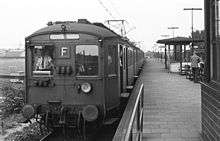
The first generation (DSB class MM-FM-MM) was introduced in 1934 at the opening of the network, and consisted of three carriages per train set (2 motor cars and 1 trailer car), manufactured from 1934 to 1962. Frichs A/S supplied the electric components while Scandia (now Bombardier Transportation Denmark) supplied the car bodies and non-electric components. They were retired in 1978, and one was used as a heritage train until 2003, when DSB decided to discontinue its use. They are the longest serving S-train rolling stock to date, in continuous service for 44 years.
Second generation (1967-2007)
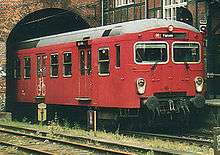
The second generation (DSB class MM-FU-MU-FS) was built from 1967 to 1978 by Frichs A/S (motored cars) and Scandia (trailer cars). They saw the introduction of the signature red colour that was to characterize subsequent generations of rolling stock.
There have been three different formations: the first (2-car), had a motor car with first-class seating (could be converted to second class) and a second-class trailer; the second (2-car), had second-class seating only; and the third (4-car), a motor car with driver's cab, a trailer, a motored trailer and a driving trailer without motor.
They ran until January 7, 2007. All have been scrapped except for a few set aside for museum use. An official ceremony was held on February 3, 2007 with the last trip. One train is set to be restored by DJK (Danish Railroad Club), who are now the owners of the train, so it can eventually make its way back to the tracks on special occasions such as anniversaries.
Third generation (1986-2006)
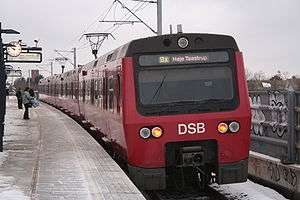
The third generation (DSB class FC-MC-MC-FC) were built by the Swedish industrial firm ASEA from 1985 to 1986. Despite possessing a much improved level of passenger comfort as compared to the previous two generations of rolling stock, it suffered a much higher rate of failure as compared to its predecessors. Twelve trains in 4-car formation (48 cars) were built (a further 32 4-car trains were not realised), and it first entered service in 1986 on the Vestbane and the Nordbane (B service) between Holte and Høje Taastrup. They were the first S-train rolling stock to feature electronic chopper control. In 1995, 4 trains (16 cars) were scrapped and the remaining 8 trains (32 cars) were refurbished and reassigned to the Ringbane (F service), where they remained in service until an incident where a child was trapped between the doors forced their early retirement in June 2006. When attempts to sell them failed, they were transported to Holbæk harbour on August 23, 2007 in order to be scrapped.
Fourth generation (1996-present)

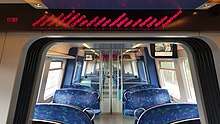
The fourth generation, in service since 1996, are distinguished by their plump appearance due to their curved sides.
They are usually 8-car articulated units (DSB class SA-SB-SC-SD-SD-SC-SB-SA, also known as Litra SA) supplied by Alstom-LHB and Siemens with prefabricated friction stir welded aluminium roof panels made by Marine Aluminium from Sapa extrusions, and were manufactured from 1996 to 2007. The cars are shorter than conventional railway cars; each has a single axle under one end, the other end being supported by the neighbouring car. (The end cars have two axles each). They have automatic Scharfenberg couplers at the ends; in peak hours most trains consist of two coupled units, giving a total train length of 168 meters.[11] They have video surveillance to ensure passenger and staff security and to prevent acts of vandalism. These trains introduced air conditioning in the interior and regenerative braking to the network, increasing energy efficiency. At present, there are 105 8-car trains (840 cars).
An accident involving an 8-car fourth-generation train in 2002 caused it to be scrapped, necessitated the construction of 4-car sets to relieve the shortage of trains. These 4-car units (DSB class SE-SH, also known as Litra SE) can run solo in low-traffic intervals. At present, there are 31 4-car trains (124 cars) serving the S-train network.
The top speed of fourth-generation trains is 120 km/h (75 mph), although on many parts of the network their speed is limited to 90 km/h (56 mph)-100 km/h (62 mph) due to the limitations of the signalling system, and on the Ringbane they travel at 80 km/h (50 mph).[12]
Origin of the name
The letter S in "S-train" does not abbreviate any particular word. It originates in hexagonal illuminated "S" signs that were put up at stations before the opening in 1934. These signs may have been inspired by similar signs at the S-Bahn systems in Berlin and Hamburg, but their official purpose appears to have been to mark the location of a Station.
In February–March 1934, the newspaper Politiken asked its readers to coin a name for the new network. "S-train" was the winning proposal, made independently by several readers. The judges' panel (headed by the director-general of the DSB) cited a long list of possible explanations, including choices such as "state railways", "city railway", "Greater Copenhagen", "sun", "lake", "forest", "beach", "snow", "skiing", "skating", "sleigh", all of which start with an S in Danish. This demonstrates that the initial marketing of the S-trains emphasized recreational day trips from the city to the countryside.
See also
| Wikimedia Commons has media related to S-train. |
References
- DSB’s resultat før skat i 2016 blev et minus på 2.193 mio. kr
- "Virksomheden DSB S-tog a/s" (PDF) (in Danish). Archived from the original (PDF) on 2012-07-28.
- "DSB: studiemateriale - milepaele-i-jernbanens-historie - S-tog år for år" (in Danish). Dsb.dk. Archived from the original on 2016-03-26. Retrieved 2013-08-05.
- "Pressemeddelelser - Nu er der fri internet i S-togene" (in Danish). Dsb.dk. 2009-11-02. Retrieved 2013-08-17.
- "S-togsstation og ny bydel i Vinge".
- http://www.byenvinge.dk/da/indhold/vinge
- PDF at
- Danish Transport, Construction and Housing Authority (December 2019). "S-tog til Roskilde" (PDF).
- http://ing.dk/artikel/ekspert-s-tog-paa-kystbanen-er-en-kaempe-udfordring-104563
- https://www.bane.dk/da/Borger/Baneprojekter/Signalprogrammet/S_bane/Fra-HKT-til-CBTC
- "S-tog". Danske Statsbaner. Archived from the original on 2009-05-05. Retrieved 2008-07-12.
- "SA-SB-SC-SD". Danske Statsbaner. Archived from the original on 2009-05-05. Retrieved 2008-07-12.
